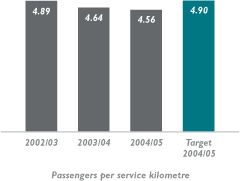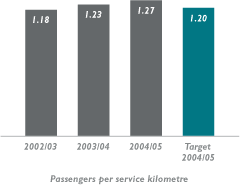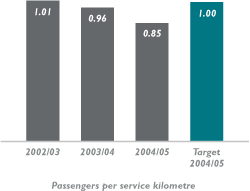Outcome
1: Accessible, reliable and
safe public transport system
PTA’s outcome of an accessible,
reliable and safe public
transport system is seen as a key requirement for
increasing the use of public transport. Achieving a
sustainable increase in the use of public transport
depends on accessibility, reliability and safety.
PTA’s
effectiveness in meeting its outcome on the
provision of accessible, reliable and safe public
transport system is measured by the following criteria:
- Use
of public transport
- Accessible public transport
- Service reliability
- Level of overall customer satisfaction
- Customer perception of safety
- Level of notifiable safety incidents
1 Use of public transport
The use of public transport is measured
by comparing
the annual number of passengers carried against the
number of productive service kilometres. Productive
service kilometres exclude those kilometres travelled
outside of scheduled passenger services (e.g.moving of
trains and buses to stations).
This effectiveness indicator
is applied to each mode of
public transport.
Metropolitan and regional
passenger services
Transperth Train Operations

The extension of the rail
network to Clarkson and
opening of Greenwood station resulted in increasing
service kilometres by 6.9%. Despite a 6.3% increase in
fare-paying boardings, train total boardings, which
includes transfers and free travel, only rose by 4.9%
due partly to a reduction in the number of boardings
within the Free Transit Zone as shown by the March |
2004
passenger count. The target was based on the
assumption that free travel would remain unchanged
and that Clarkson, Greenwood and Thornlie stations
would commence operations earlier.
Transperth Bus Operations

This indicator is based on total boardings which
includes fare-paying boardings plus free travel and
transfers. Fare-paying boardings increased by 2% in
2004/05 while the new passenger count on Central
Area Transit and Free Transit Zone services carried out
in March 2004, calculated that free travel had increased
by 35%. The significant variance in 2004/05 as
compared to the target is as a result of the inclusion of
the higher level of free travel in the total boardings.
Regional
Bus Services

The patronage for the regional bus services declined
despite an 11.6% increase in the service kilometres.
This was as a result of the expansion of some regional
services which involves high service kilometres for a
relatively small number of passengers. |

